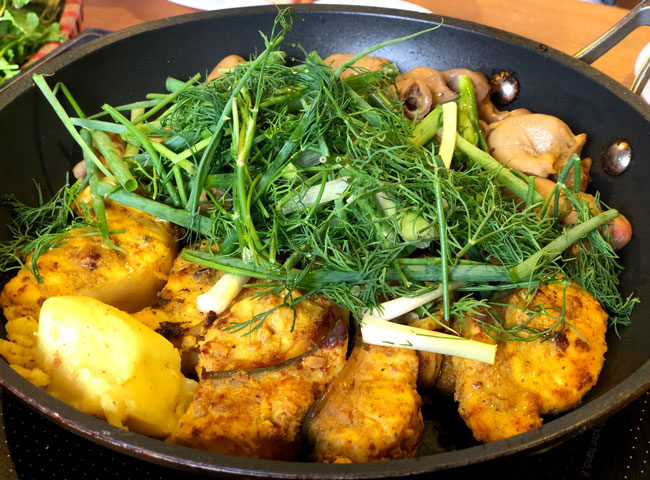What is Cha Ca La Vong?
Cha
Ca La Vong, or Cha Ca Hanoi, is the term widely used in Vietnam to
refer to a dish consisting of boneless grilled snakehead fish or
hemibagrus (a type of river catfish), which is then fried table-side in
front of diners with tons of fresh dill and spring onion, for eating
with rice noodle, cilantro, roasted peanuts, and shrimp paste.

The origin of the dish traces back to the early days of Vietnamese fighting against the colonial French, when Doan family, at 14 Hang Son Street in Hanoi’s Old Quarter, cooked their fresh catch fishes for patriots who were using their home as a secret meeting place.
Overtime,
diners called the dish “Cha Ca La Vong” (the “La Vong” is the name of a
statue at the family’s door step), and the family turned itself to a
restaurant serving that only dish. Eventually, the Hang Son (Paint
Street) was officially renamed to Cha Ca Street in honor of the famous
dish.
How Cha Ca Hanoi is Served?
To
prepare Cha Ca La Vong, small chucks of boneless catfish are marinated
with turmeric, fermented rice, and galangal, which is then grilled on
charcoal fire. These saffron-colored fish chucks, with its natural
juices trapped inside, are then served on a sizzling cast-iron skillet
for a crispy outer crust.


Diners
will then fry their own grilled fish chucks with tons of dill and
spring onion till the herbs had slightly wilted, featuring a whiff of
aromatic dill. Put a small amount of rice noodle into the bowl, add some
herbs (coriander and basil), take some fried dills, spring onions, and
one piece of fish to the same bowl.
Scoop some shrimp
paste over, sprinkle the peanuts and sliced red chilli over, then they
are all set to dig in. The fish are fresh, tender, and it would has a
slight muddy taste, but that would be concealed once they pair the fish
with lots of dill and spring onions.


Hanoians are pretty specific in terms of when and where to have cha ca, just
to make sure the dish would bring out all the necessary flavors. As a
true local connoisseur would say, it’s best to eat Cha Ca Hanoi on a
chilling day with some home-cooked rice liquor, and the best place eat them is the Old Quarter.
Where to Eat Cha Ca in Hanoi’s Old Quarter?
As
Hanoi’s restaurant scene continues to evolve, Cha Ca Hanoi is no longer
contained to its namesake street. Modern interpretations of the beloved
fish dish can be found at contemporary restaurants around the city.
Following are the best places eat this incredible fish dish.
1. Cha Ca La Vong
This
is one of the oldest eateries in Hanoi, and the dish was first created
here over a century ago. There is nothing fancy in this tiny eatery,
except for the fact that it was owned by the Doan family, thus feeling
original.
Almost
everything here is kept intact for decades, so if you venture to this
original place, it’ll be like stepping back in time. However, this
family-run restaurant receives quite a lot of negative reviews about
service and quality, especially about how overly greasy their cha ca is.
- Cha Ca La Vong
- 14 Cha Ca Street, Hoan Kiem, Hanoi
- 10h00 – 22h00
2. Cha Ca Thang Long
This
restaurant is likely the more preparable place for locals, since its
space is much larger than the original Cha Ca La Vong. The service and
quality of the dish are said to be much better than most other places
serving the same dishes, including the original place.
- Cha Ca Thang Long
- 21 – 29 Duong Thanh, Hoan Kiem, Hanoi
- 10h00 – 22h00
Though Cha Ca La Vong doesn’t
appear in any top 10 list, don’t miss the chance to try it when you’re
in Hanoi, and perhaps, you also wish to try some of these 25 Hanoi’s street food. JoinFlavors of Hanoi’s peronal foodie tour guide on our daily walking Hanoi food tour, and explore the best of what the city has to offer.
It is then grilled on
both sides with dill and spring onions and served with vermicelli
noodles, roasted peanuts, and a dipping sauce consisting of lime juice,
garlic, fish sauce, and sugar. This dish dates back to the French
Indochina days of Vietnam, and the resistance fighters used to meet in
the Old Quarter of Hanoi.Their secret
meeting place served grilled fish (chả cá), and outside of the
establishment, there was a statue of Lã Vọng, a famous poet and
resistance fighter, hence the name of the dish.